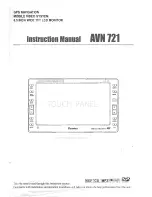
1
How GPS and Cartography Work
Your 700 Series™ Chartplotter supports GPS and chartplotting. It uses GPS
to determine your position and display it on a grid. The Global Positioning
System (GPS) is a satellite navigation system designed and maintained by the
U.S. Department of Defense. GPS was originally intended for military use;
however, civilians may also take advantage of its highly accurate position
capabilities, typically /- 4.5 meters, depending on conditions. This
means that 95% of the time, the GPS receiver will read a location within 4.5
meters of your actual position. Your GPS Receiver also uses information from
WAAS (the Wide Area Augmentation System), EGNOS (the European
Geostationary Navigation Overlay Service), and MSAS (the MTSAT Satellite
Augmentation System) satellites if they are available in your area.
GPS uses a constellation of over 24 satellites that
continually send radio signals to the earth. Your
present position is determined by receiving signals
from up to 16 satellites and measuring the
distance from the satellites.
All satellites broadcast a uniquely coded signal
once per second at exactly the same time. The GPS
receiver on your boat receives signals from
satellites that are visible to it. Based on time
differences between each received signal, the GPS receiver determines its
distance to each satellite. With distances known, the GPS receiver mathematically
triangulates its own position. With once per second updates, the GPS receiver
then calculates its velocity and bearing.
How GPS and Cartography Work
Summary of Contents for 786ci
Page 65: ...56 Setup Tab Normal Mode Setup Tab Advanced Mode Main Menu ...
Page 136: ...127 Notes ...
Page 137: ...128 Notes ...











































